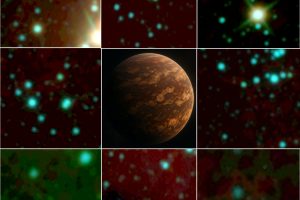“Spectroscopy of Free-Floating Planetary-Mass Objects and their disks with JWST” by B. Damian (University of St Andrews): eight isolated planetary-mass objects caught by the James Webb Space Telescope

Eight free-floating planetary-mass objects, identified in three star-forming regions, exhibit unique features: signs of ongoing planet formation and silicate-rich clouds in their photospheres.
It was in the year 2000 that we first learned of the possible existence of free-floating planetary-mass objects—not bound to any exoplanetary system—thanks to observations analyzed by two research groups, one from the Institute of Astrophysics of the Canary Islands and the other from the University of Hertfordshire. These teams were the first to identify two such small objects in star-forming regions in the direction of the Orion constellation.
These are, of course, extremely difficult objects to observe: small and cold, they emit faintly in the infrared, making them challenging to detect. Nevertheless, they are of great scientific interest, as they can provide valuable insights into the mechanisms that eject gas giants from young planetary systems and help define the lower mass limit of products formed through stellar formation processes. Furthermore, if these objects form like stars—but fail to accumulate enough mass to trigger thermonuclear reactions in their cores—could miniature planetary systems form around them?
Today, we can begin to answer these questions thanks to the James Webb Space Telescope (JWST), a collaboration between NASA, ESA, and CSA. With its exceptional sensitivity in the infrared, JWST mirrors are able to capture enough light from these small objects to allow for detailed analysis of their physical and chemical properties.
In the article “Spectroscopy of Free-Floating Planetary-Mass Objects and their disks with JWST”, recently published in The Astronomical Journal, the team led by astrophysicist B. Damian (School of Physics & Astronomy, University of St Andrews) analyzed JWST observations of eight free-floating planetary-mass objects in the star-forming regions of Taurus, Chamaeleon I, and ρ Ophiuchi. These observations enabled the classification of the objects, with estimated masses ranging from 5 to 10 Jupiter masses and effective temperatures between 1600 and 1900 K.
In six out of these eight objects, the data reveal the presence of protoplanetary disks—disk-shaped structures from which planetary systems form around stars. In these cases, the disks exhibit features consistent with the presence of micrometer solid particles (grains) of silicates of varying size and crystallinity—key ingredients for initiating planet formation.
Additionally, in one object, silicate grains were detected even in the absence of a protoplanetary disk. In this case, astronomers believe the radiation absorption is due to silicate-rich clouds suspended in the object’s photosphere. Not only are these the lowest-mass objects known to exhibit such properties, but they also demonstrate that scientifically intriguing phenomena can occur even in free-floating planetary-mass bodies.
Among the co-authors of the study is astrophysicist V. Almendros Abad of INAF – Osservatorio Astronomico di Palermo.
The cover image (click here to view in full) shows a collection of WISE mid-infrared images of the objects analyzed in the study (each one faint and located at the center of its panel). The central panel presents an AI-generated artistic rendering of a brown dwarf with atmospheric clouds.
Mario Giuseppe Guarcello
Follow MarioSpiegaCose on Instagram () , Facebook (), Youtube (), and X ()
Follow the Astronomical Observatory of Palermo on Facebok and on Instagram
Subscribe the Youtube channel of the Astronomical Observatory of Palermo
